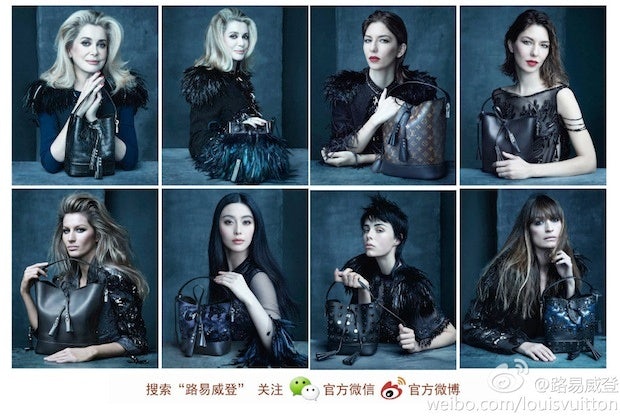
Louis Vuitton's ad campaign for 2014 that was posted on Sina Weibo. (Louis Vuitton/Sina Weibo)
Despite yearlong worries about China's luxury slowdown, the world’s largest luxury conglomerate saw 8 percent China revenue growth in 2013, according to its annual financial numbers that were released yesterday. The main strategy for LVMH Moët Hennessy Louis Vuitton this year was to aim for greater exclusivity at a time when many Chinese consumers have been shunning ostentatious luxury goods, and according to executives, it's going to stay that way for the coming year.
After yearlong concerns about Europe’s continued economic downturn and slowing China growth, the company’s overall profits climbed by only 0.4 percent compared to 2012, but a 7 percent rise in fashion and leather goods caused shares to spike today.
A major factor in these numbers was China, which challenged the company on a number of fronts in 2013 as the government’s anti-corruption crackdown remained in high gear and customers turned away from logo-heavy products. In addition, high tariffs appeared to take a toll on mainland sales—the 8 percent growth number climbs to 15 percent with Hong Kong and Macau included, which do not have the mainland’s massive markups on imported goods.
According to company CFO Jean-Jacques Guiony in a conference call to discuss the annual report, China will continue to be a challenge in the coming year. In his view, “it’s pretty difficult to arrive at a long-term outlook” for the country, but the company has “positive signals coming in” as it continues to strategize.
When it came to the company’s fashion cash cow Louis Vuitton, exclusivity was the main growth strategy for the year. This plan isn’t likely to change for 2014 as the brand battles massive China overexposure and rampant fakes. One main aspect of this strategy is avoiding store openings outside China’s first-tier cities, said Guiony. “I can confirm the idea is not to develop in the second-rate or fourth-rate cities in China,” he said. “We do want to keep our presence in China in iconic areas.” According to him, the number of new China stores grew by between 8 and 9 percent in 2013 compared to 2012, but this “will level off to 4 percent, 5 percent over the next three or four years.” Instead, Louis Vuitton will be focusing on renovation and refurbishment of existing stores in the region. In addition, the company will continue to develop its smaller labels such as Céline. "Now of course, Louis Vuitton is not the only brand, we have about 60 odd brands," Guiony reminded investors.
This exclusivity factor was also part of the company’s wine and spirits strategy in China as demand slumped in the wake of the government’s austerity drive. LVMH joined Diageo, Pernod Ricard, and Remy Cointreau in reporting slower sales growth in China for 2013, which caused the brand to resort to “significant destocking” of its Cognac in the country, said Guiony. “For Cognac we had too much stock there,” and the conglomerate “decided to reduce sales voluntarily in the fourth quarter in China.” He predicts that “there will be growth, but less so this year.” Some of this growth may be driven by its plan to develop demand for drinks that remain novel in China. According to company CFO Christophe Navarre, “We’re creating a market for Champagne that’s a new opportunity.”
In the selective retail division, which includes Sephora and duty-free luxury retailer DFS, Chinese travelers continued to boost sales to a 13 percent growth rate despite the new travel law that was enacted this year. “Regarding the new travel restrictions for Chinese nationals, the effects on DFS were rather minor, it’s only a few shops in Hong Kong, Singapore and Australia that were affected,” said Guiony. “There were more effects in traffic with less affects in sales because the people who travel less were people who are spending less anyway.”
Overall, LVMH is looking at the long-term growth potential in China, he said. “The growth potential for emerging economies is quite significant and significantly higher than here. What we are looking at now is that 10-year or 15-year outlook.”